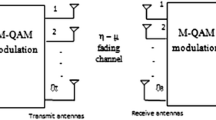Abstract
High performance of MIMO-OFDM wireless systems is very much desirable. In this paper, we study the performance analysis of scheduling schemes for multiuser MIMO-OFDM systems employing Orthogonal Space-Frequency Block Coding in η–µ fading scenario over frequency selective fading channels. We analyze the advantages of user scheduling in MIMO-OFDM systems employing OSFBC and adaptive modulation schemes. It can be noted that η–µ distribution includes Nakagami-m and Hoyt distributions as special cases. Analytical expressions for average spectral efficiency (ASE), average bit error rate (BER), and outage probability for scheduling schemes are derived. Both full-feedback and limited-feedback channel information scenarios are considered. Using the results obtained from both mathematical expressions and numerical simulations, the ASE and BER are compared and discussed.







Similar content being viewed by others
References
M. Torabi, W. Ajib and D. Haccoun, Performance analysis of scheduling schemes for rate-adaptive MIMO-OSFBC-OFDM systems, IEEE Transactions on Vehicular Technology, Vol. 59, No. 5, pp. 2363–2379, 2010.
M. Jiang and L. Hanzo, Multiuser MIMO-OFDM for next generation wireless systems, Proceedings of the IEEE, Vol. 95, No. 7, pp. 1430–1469, 2007.
H. Shin and J. H. Lee, Performance analysis of space-time block codes over keyhole Nakagami-m fading channels, IEEE Transactions on Vehicular Technology, Vol. 53, No. 2, pp. 351–362, 2004.
D. B. Da Costa and M. D. Yacoub, The η–µ joint phase-envelope distribution, IEEE Antennas and Wireless Propagation Letters, Vol. 6, No. 5, pp. 195–198, 2007.
W. Ajib and D. Haccoun, An overview of scheduling algorithms in MIMO-based fourth-generation wireless systems, IEEE Network, Vol. 19, No. 5, pp. 43–48, 2005.
T. Keller and L. Hanzo, Adaptive multicarrier modulation: A convenient framework for time-frequency processing in wireless communications, Proceedings of the IEEE, Vol. 88, No. 5, pp. 609–640, 2000.
S. R. Krishna and V. Bhaskar, Spectrum efficiency for rate-adaptive MIMO-OSFBC-OFDM systems over various adaptation policies, International Journal of Soft Computing and Engineering (IJSE), Vol. 2, No. 3, pp. 81–85, 2012.
S. J. Sharma and V. Bhaskar, Performance analysis of MIMO-OFDM in various outdoor fading environments, International Journal ofElectronics and Communications, Vol. 66, No. 10, pp. 797–805, 2012.
S. Shyamala and V. Bhaskar, Capacity of multiuser MIMO-OFDM systems with doubly correlated channels for various fading distributions, IET Communications, Vol. 5, No. 9, pp. 1230–1236, 2011.
P. S. Rajan and V. Bhaskar, Novel finite summation expressions for total interference power due to carrier frequency offset in uplink multiuser OFDM systems, Wireless Personal Communications, Vol. 72, pp. 2587–2604, 2013. doi:10.1007/s11277-013-1168-y.
V. Tarokh, H. Jafarkhani and A. R. Calderbank, Space-time block codes from orthogonal designs, IEEE Transactions on Information Theory, Vol. 45, No. 5, pp. 1456–1467, 1999.
M. D. Yacoub, The κ–μ distribution and the η–μ distribution, IEEE Antennas and Propagation Magazine, Vol. 49, No. 1, pp. 68–81, 2007.
I. Gradshteyn, and I. Ryzhik, Table of Integrals, Series, and Products, Academic Press, Seventh edition, 2007.
L. Hanzo, C. H. Wong and M. S. Yee, Adaptive Wireless Transceivers: Turbo-Coded, Turbo-Equalized and Space-Time Coded TDMA, CDMA and OFDM Systems, WileyNew Jersey, 2002.
D. Gesbert, and M. S. Alouini, “How much feedback is multiuser diversity really worth?,” Proceedings of the IEEE Vehicular Technology Conference, VTC 2004-Fall, Paris, France, pp. 234–238, June 2004.
M. Torabi, S. Aissa and M. Soleymani, On the BER performance of space-frequency block coded OFDM systems in fading MIMO channels, IEEE Transactions on Wireless Communications, Vol. 6, No. 4, pp. 1366–1373, 2007.
A. J. Goldsmith and S. G. Chua, Variable-rate variable-power M-QAM for fading channels, IEEE Transactions on Communications, Vol. 45, No. 10, pp. 1218–1230, 1997.
Author information
Authors and Affiliations
Corresponding author
Rights and permissions
About this article
Cite this article
Raj, U., Bhaskar, V. Performance Analysis of SNR Based Scheduling Scheme for MIMO OSFBC-OFDM Systems in η–µ Fading Channels. Int J Wireless Inf Networks 22, 147–156 (2015). https://doi.org/10.1007/s10776-015-0267-y
Received:
Accepted:
Published:
Issue Date:
DOI: https://doi.org/10.1007/s10776-015-0267-y




